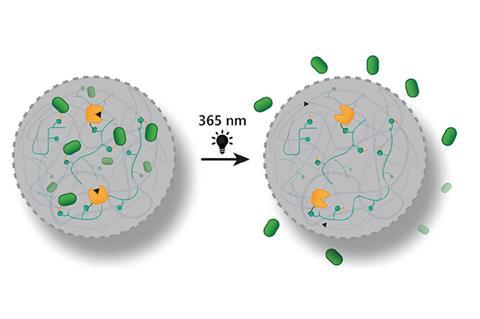
Researchers in Eindhoven have developed an artificial cell system that mimics the mutual communication of biological cells, reports Advanced Biology.
A biological cell is ingeniously designed. Take, for example, the communication system that allows cells to ‘see’ their surroundings with the help of proteins and to send signals to their neighbours, which in turn can be responded to. It is also an important component of an artificial cell that is still under development. Arjan Hazegh Nikroo, Jan van Hest and colleagues at the TU Eindhoven have developed a coacervate system that can release a protein in a controlled manner at a specific time using ultraviolet light.
Van Hest’s group has been working for a long time on coacervate systems, a polymer-rich phase in water that can form spheres that serve as a platform for a synthetic cell. They have recently succeeded in programming the uptake of histidine-tagged proteins into stabilised coacervates. If you then put a cleavage site between the protein and the histidine tag, you can get an enzyme to cleave it in such a way that the coacervate releases the protein into the environment.
This was a step in the right direction, but in this system the enzyme starts cutting as soon as it is administered, which is not how things work in a real cell. In order to have more control, the team developed a protease that can be ‘caged’ site-specifically and then activated with light at 365 nm.
Here is how it works: in a coacervate are the histidine-tagged proteins, the ‘caged’ proteases and some other stabilising molecules. As soon as you shine light on it, the ‘lock’ on the protease is released and starts to strip the proteins of their His tag. These proteins can then pass through the membrane of the coacervate into the immediate environment.
The researchers went one step further by contrasting it with another coacervate population. In the first population, the proteins are released, acting as a ‘transmitter’. The other population takes up the released proteins and binds them to other proteins in these coacervates, acting as a receiver.
Clearly, this system benefits the artificial cell, but Van Hest and his colleagues hope that it will also be used to take steps towards communication between artificial and biological cells. There is still a long way to go, but at least the work is well under way.

Hazegh Nikroo, A. et al. (2024) Adv. Biol. 2400353, DOI: 10.1002/adbi.202400353












Nog geen opmerkingen